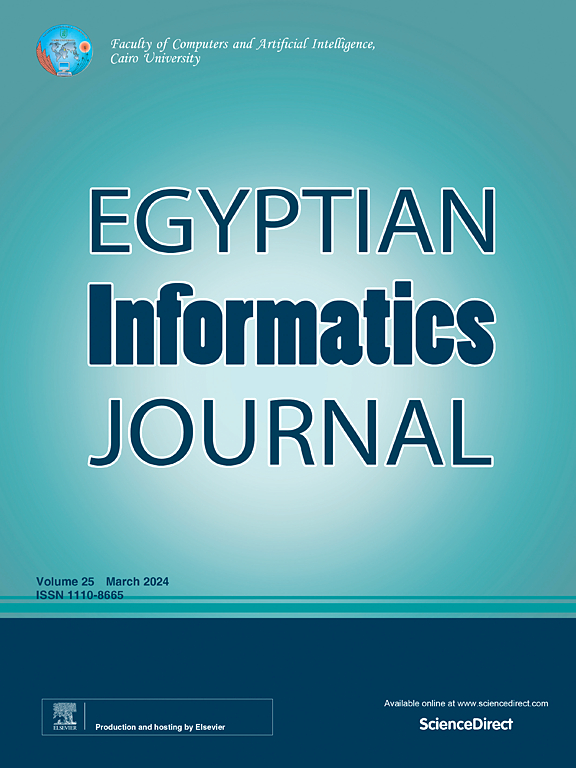基于混合算法和条件生成对抗网络的物联网安全增强入侵检测系统
IF 4.3
3区 计算机科学
Q1 COMPUTER SCIENCE, ARTIFICIAL INTELLIGENCE
引用次数: 0
摘要
本研究提出了一种新的入侵检测系统架构,旨在通过多种技术的集成来提高对物联网的保护。该系统利用包含不平衡数据的名为Bot-IoT的数据集来开发稳定的入侵检测系统。该方法分为三个阶段:数据预处理、合成数据生成和仿生混合特征选择。第一个过程包括清理、编码以及缩放机器学习算法的数据集,如极端梯度增强(XGBoost)、光梯度增强机、深度神经网络、支持向量机和决策树。第二阶段涉及使用条件生成对抗网络的新架构,具有双鉴别器结构,以增强合成数据的生成,从而改善用于训练的数据集的平衡和整体质量。描述了如何在统计上评估合成数据的有效性,以及生成的数据如何影响不同的机器学习模型。最后一步使用元启发式生物混合算法来选择特征。将鳄鱼狩猎搜索和蜜蜂优化两种方法与递归特征消除相结合,从实验数据集中选择出更优的特征。这些模型的集成允许以最小的误报实现最高水平的检测。该研究通过使用双鉴别器结构增强条件生成对抗网络(CGAN)来生成合成数据,并结合一种新的混合特征选择算法,从而推动了人工智能领域的发展。这一人工智能创新应用于入侵检测系统(IDS)的开发,旨在提高物联网(IoT)网络的网络安全。”本文章由计算机程序翻译,如有差异,请以英文原文为准。
Enhanced Intrusion Detection System Using Hybrid-Inspired Algorithms and Conditional Generative Adversarial Networks for Internet of Things Security
This research proposes a new Intrusion Detection System architecture that aims at improving the protection of IoT through the integration of multiple techniques. The system utilizes a dataset called Bot-IoT that contains unbalanced data, to develop a stable Intrusion Detection System. The methodology is divided into three stages: data pre-processing, synthetic data generation and bio-inspired hybrid features selection. The first process includes cleaning, encoding as well as scaling the data set for the machine learning algorithms such as Extreme Gradient Boosting (XGBoost), Light Gradient Boosting Machine, Deep Neural Network, Support Vector Machine, and Decision Tree to be affected. The second stage involves the use of a novel architecture of a Conditional Generative Adversarial Network, with a two-discriminator structure to enhance the generation of synthetic data that will improve the balance and the overall quality of the dataset used for training. It is described how the validity of the synthetic data is assessed statistically, and how the generated data affects different models of machine learning. The last step uses meta-heuristic bio-hybrid algorithms for selecting features. The two methods of crocodile hunting search and bee optimization are integrated with Recursive Feature Elimination to select superior features from the dataset used in the experiment. The integration of these models allows for achieving the highest levels of detection with a minimum of false positives. The research advances the field of artificial intelligence by enhancing Conditional Generative Adversarial Networks (CGAN) with a two-discriminator architecture for synthetic data generation, coupled with a novel hybrid feature selection algorithm. This AI innovation is applied to the development of an Intrusion Detection System (IDS) aimed at improving the cybersecurity of Internet of Things (IoT) networks.“
求助全文
通过发布文献求助,成功后即可免费获取论文全文。
去求助
来源期刊

Egyptian Informatics Journal
Decision Sciences-Management Science and Operations Research
CiteScore
11.10
自引率
1.90%
发文量
59
审稿时长
110 days
期刊介绍:
The Egyptian Informatics Journal is published by the Faculty of Computers and Artificial Intelligence, Cairo University. This Journal provides a forum for the state-of-the-art research and development in the fields of computing, including computer sciences, information technologies, information systems, operations research and decision support. Innovative and not-previously-published work in subjects covered by the Journal is encouraged to be submitted, whether from academic, research or commercial sources.
 求助内容:
求助内容: 应助结果提醒方式:
应助结果提醒方式:


